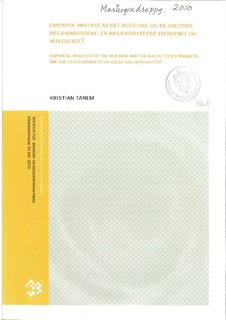| dc.description.abstract | Det russiske og de baltiske aksjemarkedene blir i utredningen testet for effisiens og integrasjon med daglig og månedlig data for perioden 2005(9) – 2010(8). ADF-test, runs-test og seriekorrelasjontester blir benyttet på aksjeindekser for å undersøke om markedene er effisiente. Resultatene viser at alle kursene følger en Random Walk. Derimot blir det funnet seriekorrelasjon mellom historiske avkastninger til samtlige indekser. Seriekorrelasjon var også konklusjonen når det ble benyttet historiske avkastninger til SP500 i stedet for egne historiske avkastninger. Det er derfor mulig å predikere morgendagens kursutvikling ved å analysere historiske kurser i egen indeks og i SP500. Aksjemarkedene i Russland og Baltikum tilfredstiller ikke kravene til svak form effisiens.
Videre ble det gjennomført ’out of sample’-strategier basert på historisk prisinformasjon for perioden 2007 – 2010. Det ble funnet en strategi for den estiske indeksen, basert på historisk prisinformasjon til SP500, som ga meravkastning i alle år hensyntatt transaksjonskostnader.
Testing av Integrasjon ble gjennomført med korrelasjonsanalyse, Grangers causality test, modellering med internasjonale aksjeindekser og Engle-Granger kointegrasjonstest. Korrelasjonen mellom avkastningene til indeksene har økt i den aktuelle perioden . Dette gjelder både internt mellom indeksene i Russland og Baltikum, og korrelasjonen med internasjonale indekser. Resultatene av kausalitetstesten viser videre at aksjemarkedene i Russland og Baltikum drives av avkastningene i andre internasjonale markeder. Aksjekursene i Russland og Baltikum ble funnet å ha en langsiktig sammenheng med aksjekursene i USA. Unntaket er imidlertid mellom aksjekursene i Estland og i USA.
Resultatene i analysen indikerte at aksjemarkedene i Russland og Baltikum ikke er attraktive med tanke på diversifisering. På tross av dette, har aksjemarkedene i Russland og Baltikum historisk sett gitt høy avkastning. Aksjemarkedene kan derfor være gode alternativer for mindre risikoaverse investorer som søker høy avkastning. This master thesis studies efficiency and integration on the stock markets of Russia and Baltic during the period 2005 – 2010, using both daily and monthly data.
ADF-test, Runs test and test for serial correlation based on regression are conducted to test for stock market efficiency. The empirical results show that the index prices follow Random Walk, despite this, the historical returns are highly serial correlated, leading to the conclusion of stock market inefficiency in Russia and Baltic. There is also found serial correlation between todays’ return in the Russian and Baltic stock markets and yesterdays return in US markets. An out of sample test is conducted to test whether a strategy based on historical price information, from both own prices and prices of SP500, may outperform a buy and hold-strategy. When Including transaction costs, there is found no strategy for the indexes in Russia, Latvia and Lithuania which outperformed the market. A strategy for the Estonian index, based on historical price information of SP500, has outperformed the market every year, including transaction costs.
Correlation analysis, Grangers causality test and Engle-Granger test for cointegration are conducted to test for stock market integration. The correlation between returns of the indexes have risen in the period, indicating lower benefits from diversification in these stock markets. The results from Grangers causality test show that the Russian and Baltic stock markets are highly driven by international stock markets. The results from the Engle-Granger test indicate a long term relationship between the Russian/Baltic stock markets and US stock market. The exeption is between Estonian and US stock markets. All these findings indicate that the stock markets in Russia and Baltic should not be used to diversify. Despite this, the stock markets have shown great oppurtunities for big returns in recent history. The Russian and Baltic stock markets may be seen as good alternatives for less riskavers investors, who are looking for high returns. | en_US |
